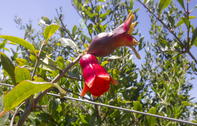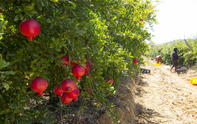The mature pomegranate is a complex fruit with an edible internal part and a hard skin that contains the colour pigment anthocyanin. The close-packed red grains (arils) and segments are separated by a non-edible white pith.

The arils contain an angular-seed surrounded by an edible juicy pulp, which produces a sweetly acid, red juice. Pomegranates grow in warm summer regions but must be protected from sunburn.
It produces self-pollinating flowers in three flushes between September and November. This means that fruit ripens over a period of time and will be harvested in three sessions.
Commercial production of pomegranates should start after three years and can yield on average 30 tons per hectare from mature trees (from six years and older), but up to 42 tons per hectare have been harvested.
Fruit are cooled down and sorted after harvest and will be sold as whole fruit or processed to juice, arils and oil (local use) or exported as fresh fruit.
Pomegranate trees will grow and produce fruit for decades so it is important that prior to planting, new pomegranate farmers choose the best cultivar from reputable nurseries, take soil samples, analyse water quality, prepare the soil to allow for deep root penetration and install irrigation, advises Jorrie Mulder, technical adviser of the Pomegranate Producers Association (POMASA).
The Best Soil for Pomegranates
Preparing the planting site for pomegranates is essential. Effective soil management prior to planting will help with root volume development. The rooting depth of a plant determines the number and quality of roots as well as growth and production of the tree.
For example, the rooting depth will influence irrigation - both the frequency (when, how often) and the volume (how much water at a time) of water. Pomegranate can successfully be grown on a wide range of soils but prefers a soil pH of 5 - 7,5.
Start with soil preparation four to five months prior to planting, such as adjusting soil pH to at least 5 with limestone and adding phosphorus if soil tests indicate as such. If required, lower the soil pH by adding sulphur.
Gypsum could also be added to neutralise excess sodium (Na) in the soil. It is important to have soil analysed. Chemical balancing and the adding of minerals should be done after a thorough study of the soil analysis results.
Similarly, new farmers may want to increase the microbial life in the soil by adding a good compost when planting, if results justify this addition. Avoid growing pomegranates on poorly drained and soils with a high clay content as this might lead to root rot. In shallow soils, the availability of soil volume per tree is smaller and the tree is more susceptible to drought and malnutrition.
Compact soils will restrict root penetration as well as oxygen, water penetration and water movement in the soil. Align the orchard rows and planting slopes for optimum sun exposure and good soil drainage.
A north-south orientation is best; the plant gets an equal amount of sunlight on both sides of the tree during the day. Try not to plant on north-facing slopes to limit sunburn and avoid areas prone to frost such as low-lying open areas.
Planting Pomegranates

The spacing of trees in a new pomegranate orchard will be determined by soil type, irrigation system, if a trellising system is to be used and the chosen cultivar. On average, between 600 and 800 trees should be planted per hectare.
Tree spacing should be as follows: at least 5 m between rows and at least 2 m between trees in a row. If an orchard is too crowded, production is lowered, fruits are set only at the top of the trees, colouring of the fruit is poor and penetration of spraying materials is not efficient.
With proper soil preparation done (e.g. ripping), soil should be loose and ready for planting. In addition, irrigation lines will already be installed. New pomegranate farmers are recommended to buy new plant material (rooted cuttings or bagged trees) from reputable nurseries only.
Rooted cuttings are planted in late winter or early spring, but bagged trees will perform better when planted during the spring or early summer. After planting, add a mulch to prevent weed growth and irrigate immediately to compact the soil and prevent roots drying out. Depending on the soil analysis results, about 100 kg/ha nitrogen (N) is given annually.
(This is a general measure and should be adapted according to the soil analysis’ results.) Leaf analysis should be done annually. This will indicate if any mineral shortages are present in the plant. This could be corrected with foliar feeds. Foliar applications are, however, a short term solution.
The best long term solution for nutrient deficiencies in plants is enriching the soil, says Jorrie. Foliar applications may include foliar zinc (Zn) after fruit set, boron (B) during flowering and liquid kelp.
It might also be necessary to reduce the nitrogen: phosphorus closer to fruit ripening, to ensure good development of the colour and accumulation of sugars in the arils. Get advice from an expert on the most suitable fertiliser programs for pomegranates.
Irrigation of Pomegranates
It is essential that water quality is tested and irrigation lines installed before planting. Despite pomegranate’s preference for hot and dry climates, the tree requires irrigation for commercial production of fruit.
Trees will grow without water but will be too stressed to produce big volumes of high-quality fruit. Irrigation tests by the Agricultural Research Council (ARC) have been concluded in 2018 and preliminary results indicated that micro-irrigation may have better results than drip irrigation.
Overhead irrigation is not advisable as pomegranate flowers are very susceptible to humidity. A general guideline for the water requirements for pomegranates would be 7 500 mᶟ/ha per season. This is equal to 750 mm of rain.
Fertilising Requirements of Pomegranates
The influence of fertilisation on pomegranates is fairly small in comparison with factors such as climate, irrigation and plant material. However, pomegranates produce a huge amount of organic matter and demand certain nutrients to replenish those and continue production.
Phosphorus and potassium need only be applied if soil or leaf analysis indicate a shortage. One of the few common deficiencies in pomegranates is zinc (Zn), recognised as a yellowing of the leaves. A foliar Zn application after fruit set is recommended. Get expert advice for a suitable fertiliser program.
By Marinda LouwFor bulk or export enquiries please use the enquiry link below.